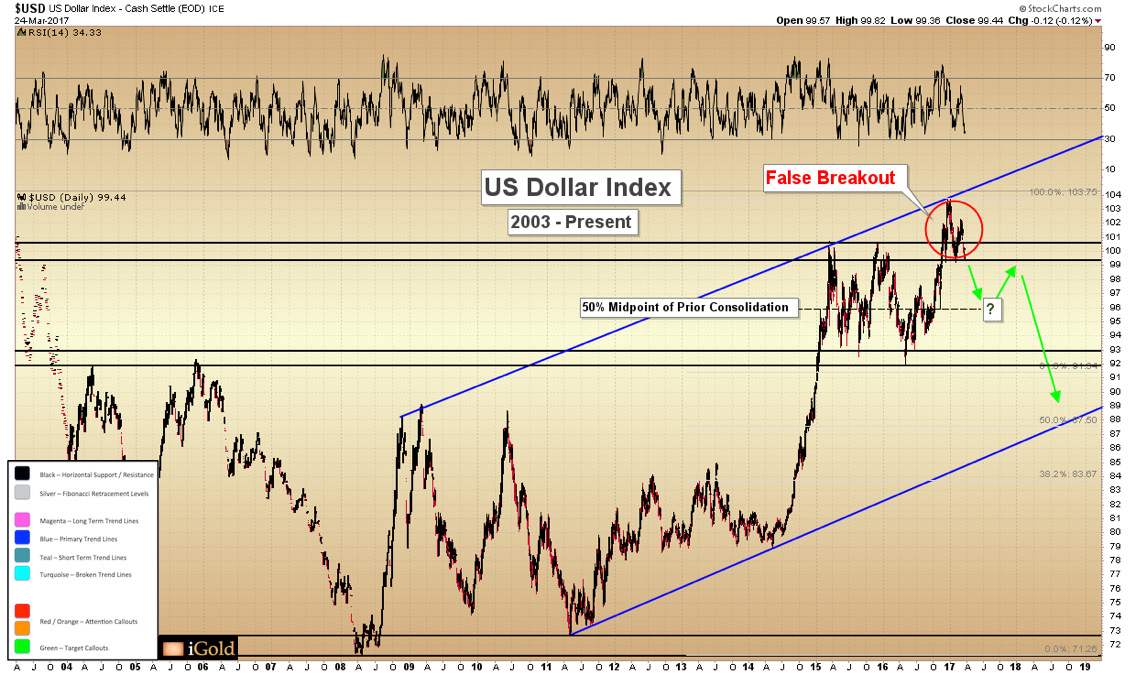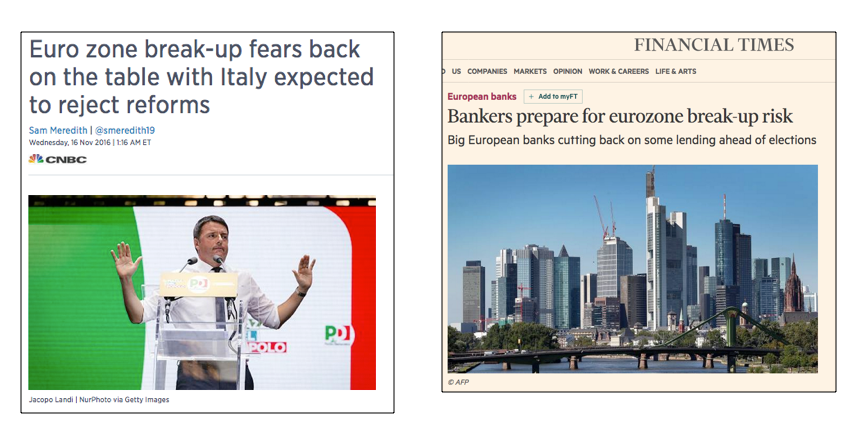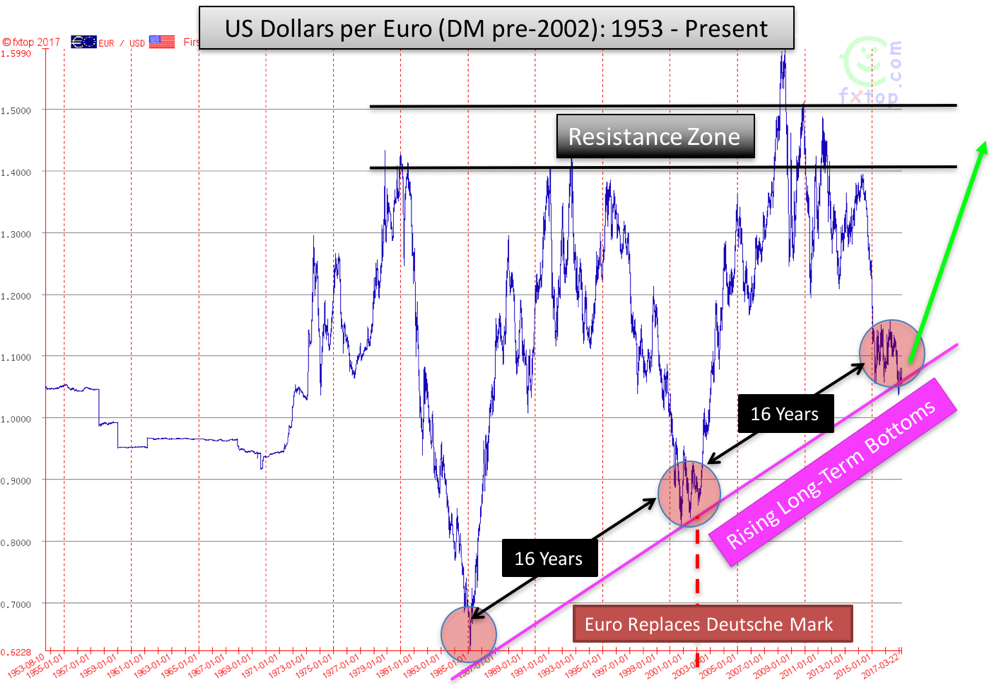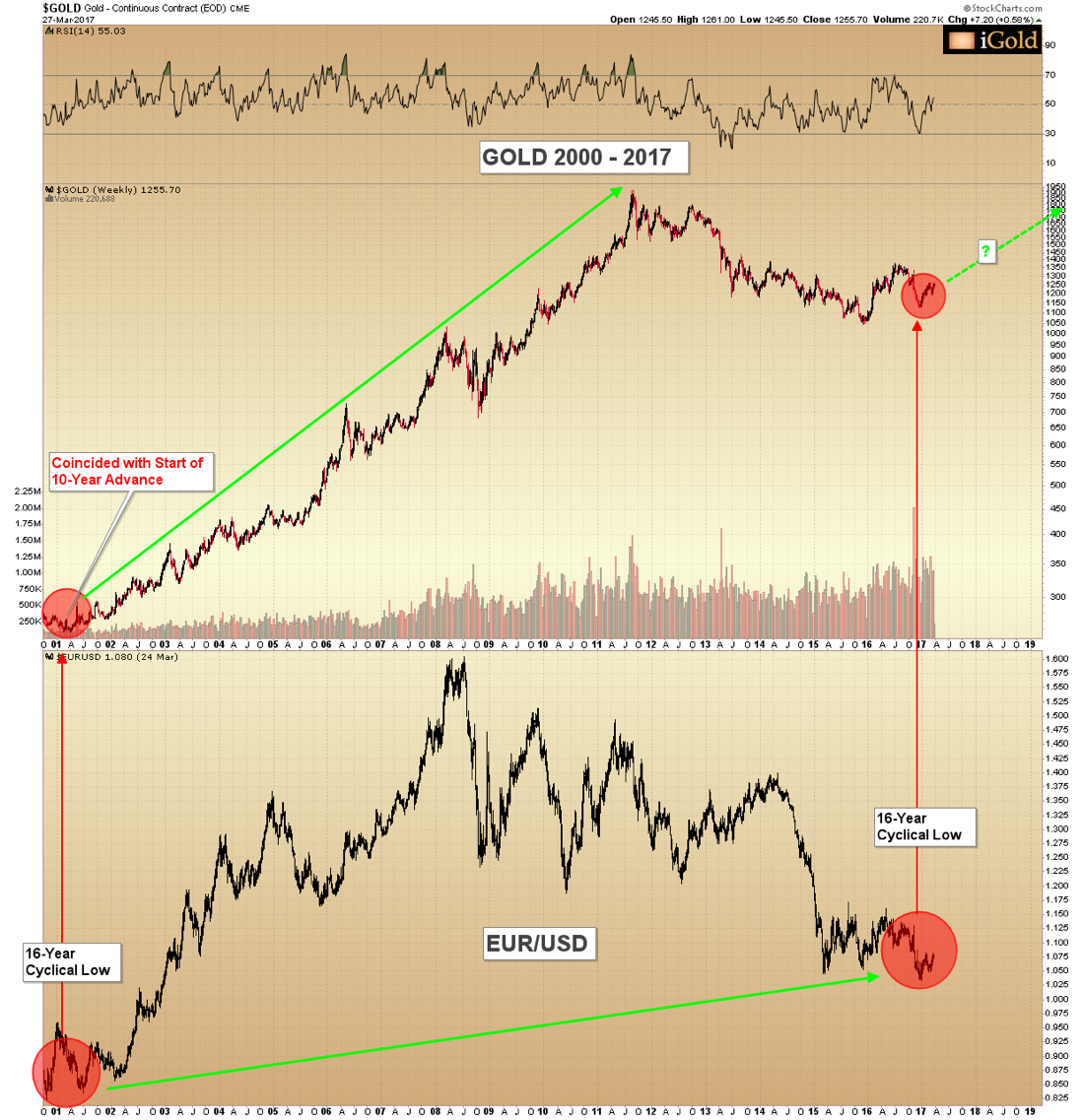US Dollar On The Verge Of A Major Reversal – Part II
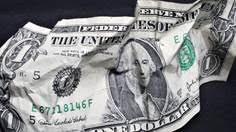
In Part I of this series, we looked at the potential for a significant reversal to be setting up in the US dollar, and how we must pay attention to the trends of the market as opposed to perceived “fundamentals” in order to avoid serious losses. In this follow-up, we continue with an examination of the longer-term ramifications for a dollar reversal, and how this might impact the euro and gold prices.
Intermediate-Term Targets For The Dollar
After the short-term weakness we anticipate in the dollar subsides, support should emerge for the dollar at 95.5 on the dollar index, shown above. The 95.5 level represents both the fulfillment of the Head & Shoulders pattern (see Part I – link above), and the 50% mid-point of the prior correction (see callout, above).
Again, this target at 95.5 should be met within the next 4-6 weeks, and from this point onward a serious technical battle will ensue.
There will be funds, institutions, and central banks heavily invested in US dollars who will attempt to halt the dollar’s decline at 95.5. A notable rebound in the dollar should be expected, perhaps back to 100 on the dollar index again, along with a correction in the precious metals. These investors will be attempting to paint the anticipated 95.5 low as simply a higher low in the series that have been forming for the last 9 years. They will then attempt to buy the dollar up to a new higher high, above the recent 103.5 top.
We believe these entities will fail to achieve a higher high, and the dollar will roll over following the bounce from 95.5.
Strong confirming data for a new dollar bear market will come when 95.5 is broken to the downside on a second attempt, by late 2017 or early 2018. A break below 92 on the dollar index will be a final “nail in the coffin” indicator that few analysts will be able to ignore.
This projection runs 12-18 months into the future in total, and we will refine the trajectory for short-term pivot points as we gather more data from the market
Summary Of Dollar Targets
The takeaway points we are now watching for the US dollar index:
-
The dollar must remain below 100 to confirm the Head & Shoulders top.
-
A short bounce at 98.5 on the rising short-term trendline.
-
A quick plunge down to the initial target of 95.5.
-
A volatile technical battle between 95.5 and the broken support lines.
-
A failure at 95.5 and the beginning of a new downward trend below 92.
Euro / USD
Why do we feel the dollar will fail at 95.5 and establish a new trend lower, and not continue higher as it has done for the last nine years?
First, in recent discussions with numerous fund managers, we have had a difficult time finding anyone willing to entertain the idea that the dollar could be set to weaken and that the euro might conversely advance. The psychology of the market seems to be predominantly dollar bullish and euro bearish.
Most mainstream financial publications agree, and sentiment nearly universally favors weakness for the euro to come. Shown below are just two samples of the many publications in recent months which have discusses the expected weakness in the euro due to a possible breakup of the EU.
The sentiment is so lop-sided against the euro at this juncture, that as contrarians we must consider the possibility that the majority of the fear based euro selling has already occurred, and that conversely, the euro may begin to strengthen versus the dollar.
What this means is that fundamentally, most fund managers and financial analysts are already short euros and long dollars. They have already made their purchases of dollars. The Head & Shoulders top formation we are seeing at the end of a 9-year advance is consistent with an exhaustion high, which forms after all who desire to buy an asset class have already done so. Nearly everyone is bullish, as everyone is already invested.
Ironically, following an exhaustion high is just when the market reverses as, by definition, when all buyers have already bought, the only participants remaining are sellers. The majority end up on the wrong side of the trade -- the price starts moving lower -- fear enters the market -- selling begets selling -- and a new bear market trend is established.
EUR / USD Long-Term Chart
Further, the technical backdrop of the EUR/USD cross-pair is at a cyclical turning point for a major multi-year low. Below we show the EUR/USD with data dating back to the post World War II era. The data for the euro pre-2002 incorporates a weighted comparison using what was and still is the largest currency component of the euro: the German Mark (DM).
Note that the series of major rising lows in the DM/euro versus the USD have occurred at nearly-symmetrical 16-year intervals. Each low has been rising, showing decreased relative strength in the dollar at each major dollar-top of the last 35 years. Meanwhile, a clear resistance and target zone has developed between 1.40 – 1.50 EUR/USD.
The advance in the EUR/USD from current levels near 1.09 to the 1.40 – 1.50 target should take 2 – 4 years to be realized.
Summary
The dollar has just confirmed a Head & Shoulders top after a multi-year advance, signaling a false breakout from the prior consolidation. The market psychology is heavily pro-dollar, which is negative from a contrarian standpoint. The euro is situated at a perfect 16-year cyclical low.
As can be seen above, the last cyclical low of this magnitude in the euro (i.e. top in the dollar) occurred in 2001.
What else began in 2001?
The last precious bull market, with gold rising from $255 to over $1,900 over the next 10 years.
History does not always repeat perfectly, but it usually rhymes. Investors should watch for gold strength to coincide with dollar weakness over the next several months as a backdrop for a more extended move which should last for several years.
********

